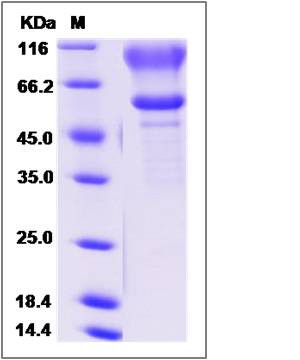Rat SPN / CD43 / Sialophorin Protein (Fc Tag)
SPN
- 100ug (NPP3129) Please inquiry
| Catalog Number | P80432-R02H |
|---|---|
| Organism Species | Rat |
| Host | Human Cells |
| Synonyms | SPN |
| Molecular Weight | The recombinant rat SPN/Fc is a disulfide-linked homodimer. The reduced monomer comprises 465 amino acids and has a predicted molecular mass of 49.3 kDa. The apparent molecular mass of the protein is approximately 95, 57 and 50 kDa in SDS-PAGE under reducing conditions due to glycosylation. |
| predicted N | Glu 20 |
| SDS-PAGE |  |
| Purity | (56.8+36.6+4.3) % as determined by SDS-PAGE |
| Protein Construction | A DNA sequence encoding the rat SPN (NP_001258015.1)(Met1-Gly243) was expressed with the Fc region of human IgG1 at the C-terminus. |
| Bio-activity | |
| Research Area | Immunology |Innate Immunity |Monocytes/Macrophages |Macrophage Markers |
| Formulation | Lyophilized from sterile PBS, pH 7.4. 1. Normally 5 % - 8 % trehalose and mannitol are added as protectants before lyophilization. Specific concentrations are included in the hardcopy of COA. |
| Background | CD43 is an abundantly expressed molecule on the T-cell surface that shows distinct localization to the migrating T-cell uropod and the distal pole complex (DPC) opposite the immunological synapse via association with the ezrin-radixin-moesin (ERM) family of actin regulatory proteins. CD43 has a 235-amino acid (aa) extracellular domain, a 23-aa transmembrane domain, and a 123-aa cytoplasmic domain, all encoded by a single exon. The intracytoplasmic region of the protein is necessary to transduce signals; it is rich in potentially phosphorylable threonines and serines but lacks tyrosine residues as well as catalytic activity. CD43 engagement on human peripheral blood T cells and monocytes leads to cell activation and proliferation through the generation of second messengers such as diacylglycerol and inositol phosphates, protein kinase C (PKC) activation and Ca2+ mobilization. In addition, CD43 ligation on human T cells induces the association of CD43 with Src family kinases, presumably through the interaction of their Src homology 3 domain with a proline-rich region of the CD43 intracytoplasmic tail. This molecule has been implicated in T cell activation, enhancing T cell response to allogeneic or mitogenic stimulation and CD43-specific signals have been reported to be sufficient to activate T cells in the absence of T cell receptor (TCR) engagement. In summary, CD43 regulates multiple T-cell functions, including T-cell activation, proliferation, apoptosis, and migration. |
| Reference |
